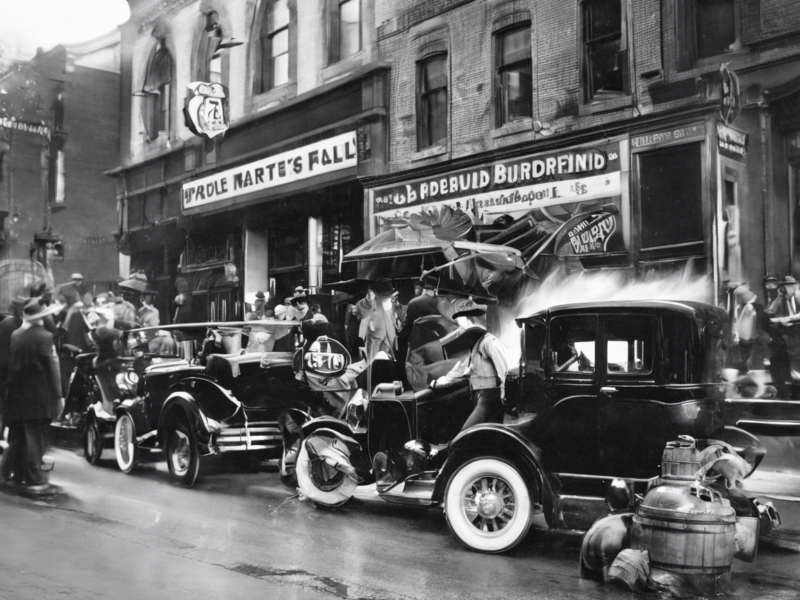Introduction
The era of Prohibition in the United States, spanning from 1920 to 1933, was a time of major social and political change. The ban on the production, importation, transportation, and sale of alcoholic beverages saw the rise of illegal speakeasies and the birth of the cocktail culture as we know it today. While Prohibition brought about many challenges and hardships, it also led to the creation of innovative cocktail recipes that have stood the test of time. In this article, we delve into the history of Prohibition and how it shaped the world of cocktails.
The Rise of Prohibition
Prohibition in the United States was enacted through the 18th Amendment to the Constitution in 1920. The temperance movement, which had been gaining momentum since the 19th century, finally succeeded in achieving nationwide prohibition of alcohol. The supporters of Prohibition believed that banning alcohol would lead to a decrease in crime, poverty, and domestic violence. However, the reality turned out to be quite different.
The Speakeasy Culture
With the outlawing of alcohol, speakeasies began to pop up across the country. These underground establishments provided a venue for people to gather and consume alcohol in secret. Speakeasies ranged from small, hidden bars to elaborate nightclubs, and they became a central part of the social scene during Prohibition. To gain entry, patrons often had to provide a password or know someone on the inside.
The Birth of Craft Cocktails
As the demand for alcohol continued despite the ban, bootleggers and bartenders alike got creative with their concoctions. The Prohibition era saw the rise of innovative cocktail recipes that used ingredients to mask the harsh taste of bootlegged spirits. Classic cocktails such as the Gimlet, Sidecar, and Bee’s Knees all have roots in this period. Bartenders became skilled in mixing drinks, experimenting with flavors, and developing new techniques that would later become staples of the craft cocktail movement.
The Influence of Prohibition on Cocktail Culture
Prohibition not only drove the creation of new cocktail recipes but also had a lasting impact on how cocktails were consumed and enjoyed. Prior to Prohibition, cocktails were mostly straightforward mixes of spirits, sugar, water, and bitters. During Prohibition, cocktails became more elaborate, often incorporating fruit juices, syrups, and liqueurs to enhance the taste of bootlegged spirits. This shift in cocktail culture laid the foundation for the elaborate and diverse cocktail menus we see in bars today.
Prohibition’s Legacy in Modern Mixology
The end of Prohibition in 1933 did not mark the end of cocktail innovation. Instead, the legacy of Prohibition lives on in the world of modern mixology. Craft cocktails have since become an art form, with bartenders continually pushing the boundaries of flavor combinations and presentation. The emphasis on fresh, quality ingredients and attention to detail in crafting the perfect drink can be traced back to the resourcefulness and creativity that flourished during Prohibition.
Frequently Asked Questions (FAQs)
Q1: What were some popular cocktails during Prohibition?
A1: Classic cocktails such as the Old Fashioned, Martini, and Manhattan gained popularity during Prohibition as bartenders sought to mask the taste of bootlegged spirits.
Q2: How did Prohibition impact the alcohol industry in the United States?
A2: Prohibition led to the closure of many breweries and distilleries, as well as the rise of illegal alcohol production and distribution networks.
Q3: Did Prohibition lead to a decrease in alcohol consumption?
A3: Contrary to the intentions of its supporters, Prohibition did not lead to a decrease in alcohol consumption. Instead, it fueled the growth of the illegal alcohol trade.
Q4: How did speakeasies operate during Prohibition?
A4: Speakeasies operated clandestinely, requiring patrons to keep their activities secret and often using passwords or hidden entrances to control access.
Q5: What is the lasting legacy of Prohibition on cocktail culture?
A5: Prohibition’s legacy on cocktail culture includes the development of craft cocktails, a focus on quality ingredients, and the redefinition of the bartender as a skilled mixologist.
Conclusion
The era of Prohibition was a defining period in American history that reshaped the way we consume and enjoy cocktails. From the clandestine speakeasies to the creative craft cocktails that emerged during this time, Prohibition left an indelible mark on cocktail culture that continues to be celebrated and innovated upon today. By understanding the historical context of Prohibition, we can gain a deeper appreciation for the artistry and creativity that go into crafting the perfect cocktail.

